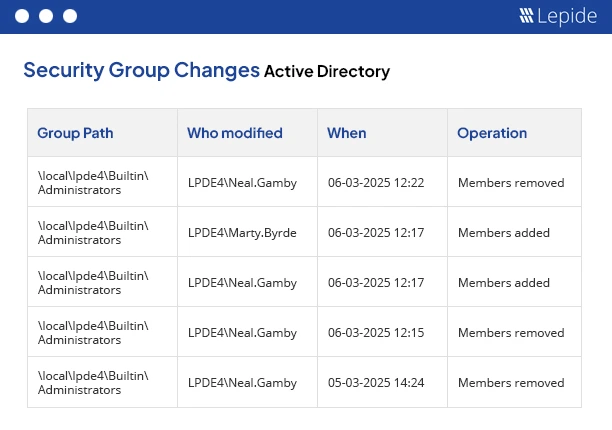
The majority of cyberattacks do not happen during peak working hours. They happen when nobody is looking at the dashboards, IT is at home, and the systems are not in place to take action. AD activity that occurs after business hours, particularly on privileged accounts, must never be ignored.
Active Directory is a prime target for attackers. It is where the user identities are resolved, access is allowed or withdrawn, and privileges are assigned or denied. That central role makes it a high-value asset for threat actors. As detailed in Lepide’s State of Active Directory Security report, nearly 25% of organizations report detecting suspicious activity outside of business hours, often linked to compromised credentials or insider threats.
Why After-Hours AD Activity Matters
You are less likely to respond quickly
Security teams are less likely to be doing any real-time logging outside of regular working hours. Automated warnings could be put on hold and take a second priority. And even when the alerts come through, they can spend hours sitting unattended.
That is precisely the breathing space that attackers require. Having got into an environment, usually via phishing, credential stuffing, or use of stale accounts, they start attacking across the lateral plane. They aim to escalate privileges, entering sensitive systems, and According to Lepide’s State of Active Directory Security report, 33% of cybersecurity incidents involve insiders accessing systems outside of business hours, often leveraging accounts that are poorly monitored or over-permissioned.
Legitimate behavior can hide threats
Not every activity after-hours is evil, and that is what makes it risky. Admins can log in late to patch a server. A developer may need to access AD to push an update. These are acceptable activities; however, they are noisy. Malicious actions can be concealed in that noise
Unless your systems have been tuned to identify behavior change, you will tend to brush off any suspicious events as non-malicious ones. In most breaches, the initial phases appear routine. The issue is that those who implement backdoors and allow unknown users to access sensitive groups are not usually real administrators.
That is why context is important. Alerts are useless when they are not correlated with baseline levels of user activities in any form (job roles, timing trends, etc.). According to Lepide’s State of Active Directory Security report, over 20% of attacks stem from compromised accounts that were not properly monitored or disabled, many of them leveraged during off-hours.
When After-Hours Activity Should Raise Red Flags
Privileged group changes and new account creation
Modifications to any sensitive groups, such as Domain Admins or Enterprise Admins or Schema Admins, that occur out of business hours must be regarded as high risk. Likewise, when creating new accounts and adding them to privileged groups is being generated at off-hours, this is a huge red flag.
Permission changes on critical assets
Unauthorized modifications to file shares, GPOs, or directory objects in the middle of the night are rarely benign. This window gives the attackers a chance to silently change the access privileges, change logging capabilities, or establish back doors. Even legitimate changes deserve to be looked over with the closest attention.
Logins from unusual locations or inactive accounts
When a dormant account is logged in at 3 a.m. and they are using a new IP address, it is no coincidence. It is an indicator. Put this together with the vulnerability of privileged systems, and there you probably have an incident.
Lepide’s State of Active Directory Security report highlights that 25% of organizations detect suspicious activity outside of business hours. That percentage likely represents only what’s visible because, without real-time monitoring, many more incidents go unnoticed.
How Lepide Helps
Lepide Active Directory Auditor is designed to detect and alert on anomalous user behavior, including activity outside of business hours. It tracks user activity, group membership changes, permission modifications, and new account creations in real time. More importantly, it offers context—who made the change, from where, and when.
Through real-time alerts, historical baselines, and anomaly detection, Lepide helps you identify the subtle patterns that indicate compromise. Whether it’s a logon attempt from a dormant account or a privileged group modification at midnight, Lepide notifies your security team instantly, so you can respond before damage is done.
Lepide’s Active Directory auditing software also offers threshold-based alerting, meaning you can define what normal looks like and get alerted when something deviates, especially after hours. Combined with its detailed audit trails, Lepide empowers IT teams to stay in control even when they’re off the clock.
As the State of Active Directory Security report makes clear, attackers rely on visibility gaps. They leverage dormant accounts, excessive privileges, and late-night logins to stay undetected. But with the right monitoring strategy and the right tools, you can flip the script.


